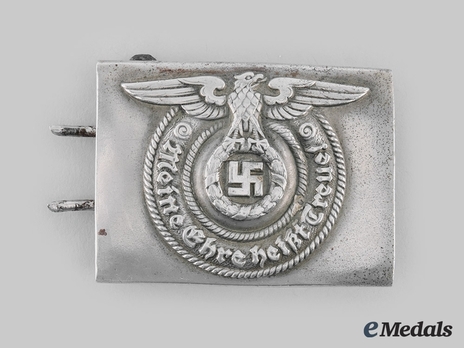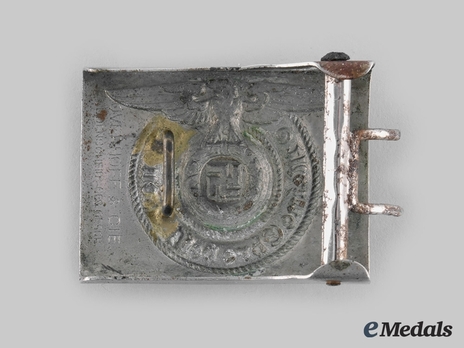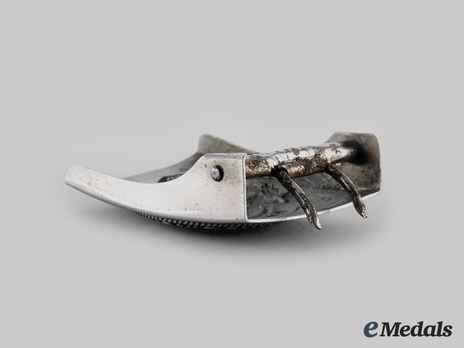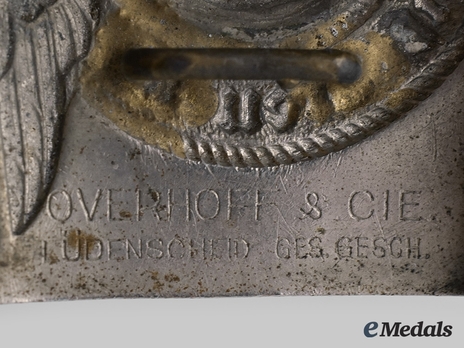Allgemeine SS NCO/EM's Belt Buckle, by Overhoff & Cie. (nickel-silver)
CATEGORY: Version
SKU: 50.GOR.02.02.02.002.000
Estimated market value:




Estimated market value:
Constructed of nickel silver, the obverse bearing a central raised SS-style German national eagle clutching a wreathed swastika, within a ribbed ring bearing a raised inscription of “MEINE EHRE HEIßT TREUE” (“MY HONOUR IS LOYALTY”), the reverse with a loop and dual attachment prongs, maker marked “OVERHOFF & CIE, LÜDENSCHEID”, measuring 64 mm (w) x 48 mm (h), minor oxidation and loss of finish is evident, in overall near extremely fine condition.
The belt buckle for Non-Commissioned Officers and Enlisten Men (NCO/EM) was introduced around 1927. Prior to this date, SS troops wore the belt buckle designed for SA personnel.
It is a box belt buckle that features the national eagle with spread wings, partially encircled by a twisted rope border. The eagle holds an enwreathed swastika in its talons, which is encircled by an additional twisted rope border. The SS motto “Meine Ehre heißt Treue” (my honour is loyalty) is embossed between these two rope borders.
From 1927 until 1931, the buckle was exclusively produced by the company of Overhoff & Cie. The buckles produced by this firm were either marked "O&C Ges. Gesch" or "Overhoff & Cie Lüdenscheid".
After 1931, Overhoff & Cie was still the primary producer, but other manufacturing firms were brought in to increase production numbers. As production was not limited to a single company, countless manufacturer’s variants can be encountered.
From 1931 until 1936, buckles were produced from nickel silver, plated brass, or plated silver. From 1937 to 1940, buckles were produced in die-struck aluminium. In 1940, the die-struck aluminium buckles were replaced with steel.
Almost all buckles feature RZM approval markings and maker’s codes.
There is a great deal of confusion surrounding early manufacturing codes as the style of coding was changed numerous times.
As of 1931, suppliers issued buckles with four to five digit part numbers. For example, Steinhauer & Lück was part number 8966.
From 1934 until 1936, buckles were marked with "RZM" and a two-digit manufacturer’s code. Only three codes are known: “24” for Overhoff & Cie, “57” for Assmann, and “63” for Steinhauer & Lück.
In 1936, buckles were stamped with RZM/SS contract numbers and the last two digits of the year of production, for example: RZM 36/40 SS.
In 1943, the SS took over control of their uniform production and afterwards, some buckles were produced featuring a marker’s logo, such as the RODO variant and the “JFS” variant (Josef Feix & Söhne).
Early examples feature clasps that were moulded to the buckle, and later examples feature clasps that were separately welded to the buckle.

Comments
Sign in to comment and reply.


Scroll Top